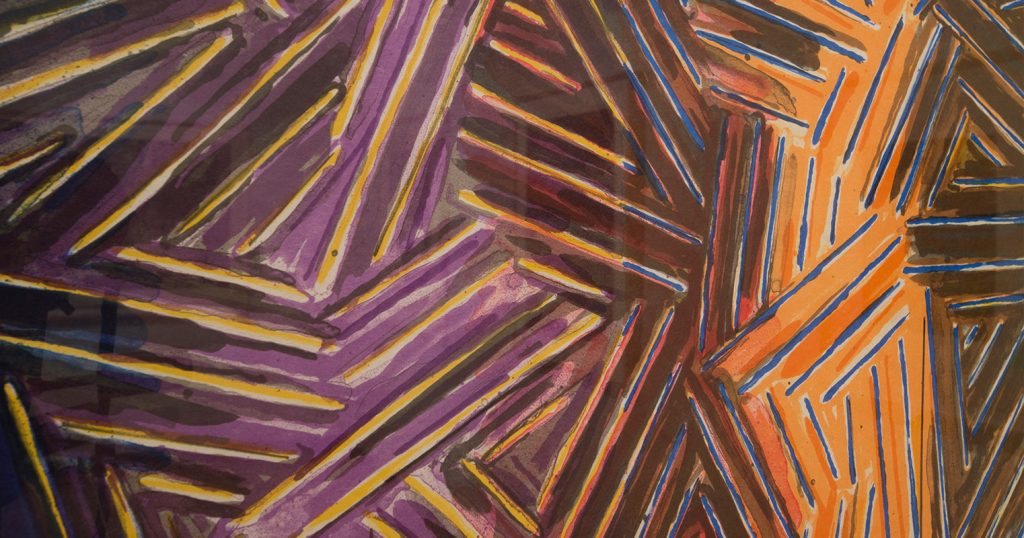

Born in 1930, Johns spent his childhood in South Carolina, and briefly attended the University of South Carolina before moving to New York in 1948. After meeting Robert Rauschenberg, Merce Cunningham, and John Cage, his work pulled away from the Abstract Expressionist style that was prevalent at that time, and he embraced a new kind of artmaking based on the premise of re-presenting the familiar in surprising ways. Johns’ work complicates the relationship between the subject and its depiction in a work of art. Johns has had one of the most illustrious careers of any American artist, with major exhibitions at New York’s Museum of Modern Art; the Metropolitan Museum of Art, New York; the National Gallery of Art, Washington, D.C.; the Centre Pompidou, Paris; the Kunstmuseum Basel, and, most recently The San Francisco Museum of Modern Art, to list a few.
Jasper Johns has long incorporated printmaking as a primary expressive form along with his painting and sculpture. He frequently creates a complex interplay of content among his paintings, prints, and sculpture. Using a variety of printmaking techniques and media, Johns builds up textured layers of imagery, often incorporating imaginative combinations of graphic images from his personal mental archive.
Johns is represented in this exhibition by a series of prints made in collaboration with master printmaker Bill Goldston at Universal Limited Art Editions, in New York. This selection emphasizes many of Johns’s recurrent motifs and themes over the past thirty years, including flags, the face-vase optical illusion, targets, galaxies, gestures from American Sign Language, paint cans, and fragments of works by such international stalwarts as Picasso, Holbein, da Vinci, and George Ohr, among others. This personal iconography has served him well, and often has been blended with family photographs and childhood mementos.
In the 1987 series The Seasons, Johns references the allegorical concept of the Ages of Man, and additionally incorporates a flotilla of other art-historical touchstones addressing this persistent subject. In fact, Johns’s art is so dense with associational possibilities that it often leads critics into pretzellike contortions trying to parse the fragmented narratives and historical references. With The Seasons, Johns provides us with a great mystery to unravel.
Johns’s work is intentionally enigmatic and even contrary. Just as you assume you are apprehending the meaning of a work, you notice that he has covertly included a contradictory element to confound any easy interpretation. It is this purposeful ambiguity that makes his work so appealing. His prints appear to contain a certain internal logic, yet they defy precise description. His focus on flags, targets, and numbers are, as he says, “things the mind already knows,” allowing for a shortcut to other ideas.
In the 1996 work Ocean, Johns offers something of a homage to his friend Merce Cunningham, featuring a portrait of the legendary dancer-choreographer as well as a performance still. All of this is embedded within a cosmos, overlaid with Buckminster Fuller’s Dymaxion earth map, showing the earth as flat—composed of one island and one ocean. These graphic choices mirror the revolutionary dancer’s life and work, fusing the cosmic with the specific—a yoking of opposites. Johns, Cunningham, and Fuller were Black Mountain College alumni, adding a further layer of cohesiveness to the work.
Johns is often lumped with such Pop artists as Warhol and Lichtenstein, but in the 1950s his brand of art was more of a reaction against the exuberance of ego-driven Abstract Expressionism. Sure, he often incorporated everyday objects and familiar images into his works, but he focused on the linearity of these objects and simultaneously deemphasized the heroic gestures of the artist. Johns was more of a hinge figure between Dada and Pop art. He has had a tremendous influence on many artists who have come after him, including Shepard Fairey. Throughout his long career, Johns has provided us with a startling array of works in a variety of media, each with its own enigmatic aura, further complicating the mysteries and meanings behind his art.
By Mark Sloan
Director and chief curator
Halsey Institute of Contemporary Art
 Supporters: South Carolina Arts Commission | City of Charleston | Baker and Cortney Bishop | Michael and Lisa Roy | Edith Howle and Rick Throckmorton | Sandy Turner and Chris Wyrick | John and Karen Vournakis
Supporters: South Carolina Arts Commission | City of Charleston | Baker and Cortney Bishop | Michael and Lisa Roy | Edith Howle and Rick Throckmorton | Sandy Turner and Chris Wyrick | John and Karen Vournakis